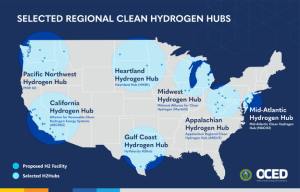The U.S. Department of Energy’s H2Hubs Program: Accelerating the Clean Hydrogen Economy
By Tanya Peacock
In a world increasingly focused on sustainable and eco-friendly solutions, clean[1] hydrogen has emerged as a promising alternative for a low-carbon energy future. On October 13, 2023, the Biden-Harris Administration announced seven U.S. regional clean hydrogen hubs spanning 16 states: Appalachian, California, Midwest, Gulf Coast, Heartland, Mid-Atlantic, and Pacific Northwest. Hubs are set to receive $7 billion in Bipartisan Infrastructure Law (BIL) funding under the U.S. Department of Energy’s (DOE) Regional Clean Hydrogen Hubs Program (H2Hubs). An additional $1 billion will be used for demand-side support to encourage industrial decarbonization and other innovative end uses. Together with an expected $42 billion in private investment, the Hubs Program represents a $50 billion investment in clean hydrogen.
The seven H2Hubs are the beginning of a national network of clean hydrogen producers and consumers, together with hydrogen storage and transportation, while supporting hundreds of thousands of new construction and permanent jobs. Skill sets required to support the clean hydrogen economy are similar to many oil and gas jobs. This is important as the energy transition accelerates so that workers in traditional energy sectors aren’t left behind.
In looking at the map below, there are areas of the country without H2Hub projects, noticeably the southwestern, northeastern, and southeastern regions, and Hawaii. The momentum created by the application and selection process is an important start and hopefully will continue to build and expand beyond the selected applications. To achieve a clean hydrogen economy, we need a nationwide network of hydrogen producers, consumers, and connective infrastructure. For example, to decarbonize long-haul, heavy-duty trucking, we will need transportation corridors with a network of H2 fueling stations. To accomplish this, ideally, selected H2Hubs will begin collaborating early-on with nearby regions that weren’t selected to leverage ideas, expertise, and resources, to accommodate the 8-10 year phased contracting approach.[2]
[1] Clean hydrogen is defined by the U.S. Department of Energy (DOE) as hydrogen produced with a carbon intensity equal to or less than 4 kilograms of CO2e produced on a well-to-gate basis per kilogram of hydrogen produced. (https://www.hydrogen.energy.gov/library/policies-acts/clean-hydrogen-production-standard)
[2] The phased contracting process, as described by OCED, is divided into 4 parts post-selection, and will take between 8-10 years: Phase 1 is the detailed planning process and is ~ 12-18 months; Phase 2 is project development, ~2-3 years; Phase 3 is construction, ~ 3-4 years; and Phase 4 is ramp-up and operations, ~ 2-4 years.
Source: Office of Clean Energy Demonstrations website
The H2Hubs are expected to collectively produce three million metric tons of hydrogen annually, reaching nearly a third of the 2030 U.S. production target and lowering emissions from hard-to-decarbonize industrial sectors that represent 30% of total U.S. carbon emissions, according to a statement issued by the DOE. Together, they will also reduce 25 million metric tons of carbon dioxide (CO2) emissions from end-uses each year—an amount roughly equivalent to the combined annual emissions of 5.5 million gasoline-powered cars. These are the figures from the press releases. To build confidence in the use of hydrogen for decarbonization, more transparency around how the projects’ community and environmental benefits are calculated will be required as the negotiation process between DOE and the selected applicants progresses and contractual agreements are finalized.
Of the 7 selected Hubs, targeted end uses include sectors that today use hydrogen from natural gas without carbon capture such as refineries, petrochemicals, and fertilizer production, and newer uses such as port operations, marine fuel, trucking, ammonia, space heating, and power generation. Clean hydrogen (production, processing, delivery, storage, and end-use) is crucial to the DOE’s strategy for achieving President Biden’s goal of a 100% clean electrical grid by 2035 and net-zero carbon emissions by 2050 because of the huge decarbonization potential.
The success of the H2Hubs and development of the clean hydrogen industry more broadly is directly linked to the Inflation Reduction Act (IRA) 45V hydrogen production tax credit (PTC). Hydrogen stakeholders have been waiting for the issuance of the IRA 45V PTC guidance document by the Internal Revenue Service (IRS) for more than a year since the IRA was signed into law. Key questions contributing to the delay center around how to increase certainty that the production and use of clean hydrogen will have a net environmental benefit and allow the flexibility needed to allow a nascent industry to develop and scale up.
Long-term techno-economic decarbonization models show that even with massive electrification and energy efficiency improvements, in 2050 as much as 50% of final energy demand globally will be met with clean molecules. The H2Hubs will play an important role demonstrating how clean hydrogen can scale up and in what sectors of the economy it can have the biggest decarbonization impact.
EcoEngineers Can Help Guide Your Clean Hydrogen Project
As companies seek to navigate the emerging clean hydrogen landscape, EcoEngineers can help project developers and their stakeholders address the factors that impact carbon intensity (CI) for clean hydrogen projects. Specifically, here’s how EcoEngineers can help:
- Life-Cycle Analysis (LCA): Eco can provide comprehensive LCA services that assess the environmental impacts of clean hydrogen production, from raw material extraction to end use. Having performed more than 500 LCAs since 2015, we have experience in all regulations that require LCAs, including the U.S. Renewable Fuel Standard (RFS), California Low-Carbon Fuel Standard (LCFS), Oregon Clean Fuels Program (CFP), Canada Clean Fuel Regulations (CFR), British Columbia Renewable and Low-Carbon Fuel Requirements (RLCFR), Brazil RenovaBio, EU Renewable Energy Directive (RED) and impending directives, along with emerging Voluntary Carbon Markets.
- Carbon Intensity (CI): We can help businesses lower their CI by identifying opportunities for efficiency improvements and carbon reduction strategies in clean hydrogen production and utilization. Lower CI values are crucial for meeting sustainability goals and accessing available incentives and credits such as the 45V clean hydrogen production tax credit under the Inflation Reduction Act (IRA).
- Project Eligibility and Compliance: Navigating the regulatory landscape is complex, and EcoEngineers can guide businesses through the process. We can ensure that projects meet eligibility requirements for incentives, grants, and compliance with federal and state regulations. With more than 200 asset development engagements and $4 billion of investments for projects across decarbonization projects and technologies, Eco’s team of experts can provide individualized guidance throughout the entire project development lifecycle of your hydrogen project. From design, build, and operational phases to regulatory and permitting guidance, technology and market risk assessments, startup optimization, and capital raising evaluations – we have you covered.
- Technology Selection: We can also provide practical guidance on technology selection, helping businesses choose the most suitable and efficient technologies for clean hydrogen production and utilization.
About EcoEngineers
EcoEngineers is a consulting, auditing, and advisory firm with an exclusive focus on the energy transition. From innovation to impact, Eco helps its clients navigate the disruption caused by carbon emissions and climate change. Eco helps organizations stay informed, measure emissions, make investment decisions, maintain compliance, and manage data through the lens of carbon accounting. Its team of engineers, scientists, auditors, consultants, and researchers live and work at the intersection of low-carbon fuel policy, innovative technologies, and the carbon marketplace. Eco was established in 2009 to steer low-carbon fuel producers through the complexities of emerging energy regulations in the United States. Today, Eco’s global team is shaping the response to climate change by advising businesses across the energy transition.

For more information about our clean hydrogen services, contact:
Tanya Peacock, Managing Director, California and Hydrogen | tpeacock@ecoengineers.us





